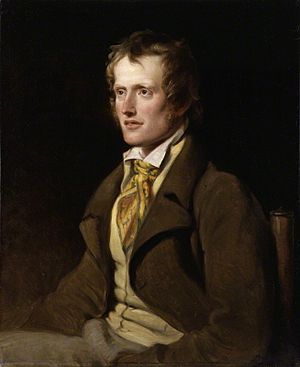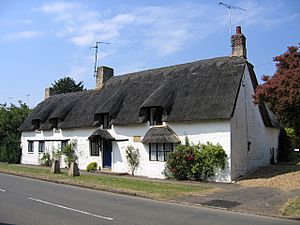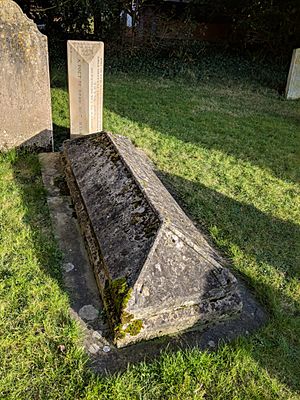John Clare facts for kids
Quick facts for kids
John Clare
|
|
|---|---|

John Clare by William Hilton,
oil on canvas, 1820 |
|
| Born | 13 July 1793 Helpston, Northamptonshire, England |
| Died | 20 May 1864 (aged 70) Northampton General Lunatic Asylum, Northampton, England |
| Genre | Rural |
| Notable works | Poems Descriptive of Rural Life and Scenery |
| Signature | |
John Clare (born 13 July 1793 – died 20 May 1864) was a famous English poet. He grew up as the son of a farm worker. John Clare became well-known for writing about the beauty of the English countryside. He also wrote about his sadness when nature was changed or destroyed.
In the late 1900s, people started to appreciate his work much more. Now, he is seen as a very important poet from the 1800s. One writer, Jonathan Bate, called Clare "the greatest labouring-class poet that England has ever produced." He added that no one has written more powerfully about nature, growing up in the countryside, or feeling lost.
Contents
Life Story
Growing Up
John Clare was born in a village called Helpston. This village is about 6 miles (10 km) north of Peterborough. During his life, Helpston was in Northamptonshire. His memorial calls him "The Northamptonshire Peasant Poet."
Clare started working on farms when he was very young. He went to school in Glinton until he was 12 years old. When he was a young man, he worked in a pub. He fell in love with Mary Joyce, but her rich farmer father would not let them be together. Later, he worked as a gardener at Burghley House. He also joined the army for a short time. He even tried living with Gypsies for a while. In 1817, he worked burning lime. The next year, he had to ask for help from the local church because he was so poor. He was quite short, about five feet tall. This might have been because he didn't get enough food as a child.
First Poems
Clare bought a book of poems called The Seasons by James Thomson. This inspired him to start writing his own poems. To help his parents avoid losing their home, Clare showed his poems to a local bookseller. The bookseller sent them to a publisher in London, John Taylor.
Taylor published Clare's book, Poems Descriptive of Rural Life and Scenery, in 1820. People loved the book! The next year, his book Village Minstrel and Other Poems came out. Everyone praised Clare. They were amazed that such a talented poet came from a humble farm worker background.
Later Years

On March 16, 1820, Clare married Martha ("Patty") Turner, who was a milkmaid. An important person, the Marquess of Exeter, gave him £15 a year. Other people also gave money, so Clare earned £45 a year. This was much more money than he had ever made before.
However, his money soon became not enough. By 1823, he was almost broke. His book The Shepherd's Calendar (1827) did not sell well. He even tried selling it himself, but it didn't help. He went back to working in the fields, and his health got a bit better. But soon, he became very ill.
Another kind person, Earl Fitzwilliam, gave him a new cottage and some land. But Clare found it hard to settle down there. He felt stuck between the world of writers in London and his neighbours who often couldn't read. He needed to write poems, but he also needed money to feed his children.
His health got worse, and he felt very sad sometimes. This got worse after his sixth child was born in 1830. Also, his poems were not selling as well. In 1832, his friends helped him move his family to a bigger cottage in Northborough. This village was not far from Helpston. But he felt even more alone there.
Clare's last book, The Rural Muse (1835), got good reviews. But it still didn't sell enough to support his wife and seven children. Clare's mental health began to get worse. He felt more and more confused about who he was. He became a burden to his family. In July 1837, his publisher friend, John Taylor, suggested he go to a private hospital. Clare went willingly to Dr. Matthew Allen's hospital near Loughton, in Epping Forest. Taylor promised Clare he would get the best care.
Clare was said to have "many strange ideas." He thought he was a prize fighter. He also believed he had two wives, Patty and Mary. Later, he started saying he was Lord Byron.
Final Years
While he was at the hospital in Essex (from 1837 to 1841), Clare rewrote poems by Lord Byron. He also claimed to be Shakespeare. He told a newspaper editor, "I'm John Clare now. I was Byron and Shakespeare formerly."
In July 1841, Clare left the hospital without permission. He walked about 80 miles (130 km) home. He believed he was going to meet his first love, Mary Joyce. He was sure they were married. He didn't believe her family when they told him she had died three years earlier. He stayed free, mostly at home in Northborough, for five months. But eventually, Patty called the doctors.
Between Christmas and New Year in 1841, Clare was taken to Northampton General Lunatic Asylum. He stayed there for the rest of his life. The doctor there, Thomas Octavius Prichard, was kind to him. He encouraged Clare to keep writing. It was there that Clare wrote his most famous poem, "I Am". In these later poems, Clare found a very special way of writing. His words became very strong and lively, like the later paintings of Van Gogh.
John Clare died from a stroke on May 20, 1864, when he was 70 years old. His body was brought back to Helpston. He was buried in St Botolph's churchyard, just as he had wished.
Remembering John Clare
On Clare's birthday, children from the John Clare School in Helpston have a special tradition. They walk through the village and place their "midsummer cushions" around his gravestone. The gravestone says, "To the Memory of John Clare The Northamptonshire Peasant Poet." It also says, "A Poet is Born not Made."
His Poetry
During his time, John Clare was often called "the Northamptonshire Peasant Poet." He didn't have much formal schooling. His other jobs and his family background were very humble. Clare liked to use the local Northamptonshire way of speaking in his poems. He used words like "pooty" (snail) and "lady-cow" (ladybird).
When he was young, he found it hard to fit his poetry into the changing styles of the time. He also felt like he didn't quite belong with other peasants. In his original writings, Clare often didn't use much punctuation. Many publishers felt they needed to add it to his work. Clare often argued with his editors about how his poems should look when printed.
Clare grew up during a time of huge changes in the countryside. The Industrial Revolution was happening across Europe. Many farm workers and craftspeople, including children, moved from the countryside to crowded cities. Factories were using machines instead of people. The Agricultural Revolution also changed the land. Fields were ploughed, trees and hedges were removed, and shared lands were fenced off. This destruction of an old way of life made Clare very sad.
His early poems show his joy in nature and the changing seasons. Poems like "Winter Evening" and "Haymaking" describe the beauty of the world. They also show the steady rhythm of farm life, where animals need feeding and crops need harvesting. Poems like "Little Trotty Wagtail" show how closely he watched wildlife. His later poems are more thoughtful. They often use styles similar to the folk songs he heard growing up.
Clare knew much more about the natural world than other famous poets of his time. His poem "I Am" shows a deep understanding of life and existence. He was one of the most important poets, besides Wordsworth, who preferred an older style of writing. A bird-watcher named Tim Dee noted that Clare wrote about 147 different kinds of British wild birds. He did this "without any technical kit whatsoever."
Renewed Interest
People didn't pay much attention to Clare's work in the late 1800s. But interest in his poems started to grow again in the early 1900s. In 1948, the famous composer Benjamin Britten used some of Clare's poems in his music.
The largest collection of Clare's original writings is kept at Peterborough Museum and Art Gallery. You can see them there by making an appointment. In 2003, a writer named Jonathan Bate published a major book about Clare's life. This helped many more people, both everyday readers and scholars, become interested in his work again.
John Clare Cottage
The small, thatched cottage where Clare was born was bought by the John Clare Trust in 2005. In 2007, the Trust received a lot of money to fix up the cottage. They also built a new visitor centre with a cafe, shop, and exhibition area. The cottage, at 12 Woodgate, Helpston, has been repaired using old building methods. It is now open for people to visit. In 2013, the Trust got more money to help keep the building safe. They also use it to offer fun learning activities for young visitors.
His Works
- Autumn
- First Love
- Nightwind
- Snow Storm.
- The Firetail.
- The Badger
- The Lament of Swordy Well
- Sunday Dip.
Poetry Collections
- Poems Descriptive of Rural Life and Scenery. London, 1820
- The Village Minstrel, and Other Poems. London, 1821
- The Shepherd's Calendar with Village Stories and Other Poems. London, 1827
- The Rural Muse. London, 1835
- Sonnet. London 1841
- Poems by John Clare. Arthur Symons (Ed.) London, 1908
- The Poems of John Clare - In two volumes. London, 1935
- Selected Poems London, 1997
John Clare and Music
John Clare's father was a "noted singer." Clare himself played the fiddle. He also collected folk songs and tunes. He said he was "a decent scraper" on the fiddle. He collected over 200 folk tunes in two notebooks.
Clare also collected many folk songs. These are written down in other notebooks. One of Clare's poems was even set to music and performed during his lifetime! The song was sung by Madame Vestris at Drury Lane Theatre in London in 1820. Clare just missed the show when he arrived in London. He wrote that he felt "uncommonly pleasd at the circumstance."
Since Clare's death, many of his poems have been turned into songs. Classical composers have used them. More recently, modern singers and songwriters have also used his words in their music.
Images for kids
See also
- Political poetry
- Proletarian poetry
- Proletarian literature




